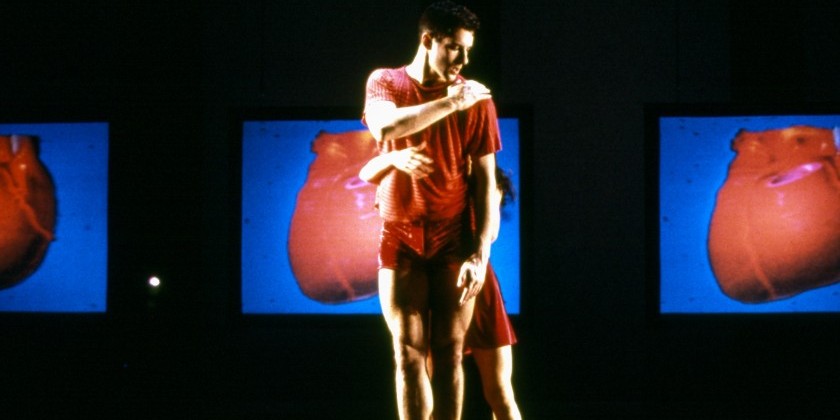AUDIENCE REVIEW: Barking/Selissen Project in "Differential Cohomology; Dance Of The Diagram"

Company:
Barking/Selissen Project
Performance Date:
April 29th & 30th 2022
Freeform Review:
Barkin/Selissen Project's Differential Cohomology; Dance of the Diagram: An Evening of Math and Dance was an experience at the intersection of math, science and contemporary dance incorporating cross cultures and meanings of life and death. The performance compassionately and unapologetically dove into the greater questions: What does it all mean? How can the science of math parallel the arts? The evening was an explicitly grounded and clear dialogue of opposite worlds coming together to cultivate their similarities and the excitement of possibilities in collaboration. Supported in part by the Alfred P. Sloan Foundation, The LMCC, and The DCLA and performed at the Gerald Lynch Theater in Manhattan on April 29th and 30th 2022, Differential Cohomology gifted audience members with an encounter of contemporary dance followed by an A list panel of experts led by moderator Heather Berlin PhD (Neuroscientist & Clinical Psychologist.) The discussion amongst academics and artists included Jim Simons (founder of the theory of Differential Cohomology), Dennis Sullivan (Abel Prize Recipient & Distinguished Math Professor), Emily Coates (Director of Dance in Theater and Performance Studies at Yale University), Yamilée Toussaint Beach (Founder of STEM From Dance), and Aaron Selissen and Kyla Barkin (Artistic Directors and Choreographers of Barkin/Selissen Project). The exquisite and simplistic charm of the costumes by Mary Jo Mecca were partially due to their limited edition fabric by Jean Paul Gautier, including basic black shorts paired with a pale, woad blue, long-sleeve jersey, designed in motifs that created the impression of a face. The outfit's design resembled the infinitely non-repeating pattern that an artist carved into the sidewalk outside the Simons Center for Geometry and Physics, for whose opening the dance was originally commissioned. This costuming was by no means distracting, rather it was an illuminating choice that added an obscure angle to an ensemble of fervor, strength and passion. With a score of angelic strings and light percussion that accentuated the vibrant vignettes, the music of Differential Cohomology by The Sirius String Quartet also proved to be a grand part of the work's equation. While the composition could stand alone, it lyrically wove each movement in tandem to perfection. Differential Cohomology is a mathematical theory discovered by now philanthropist Jim Simons, based on a hexagon-like shape and incorporates its derivatives of movement in one direction from left to right, which eventually get canceled out or disappear. The math itself took many years to prove. The ideas and discussion around this geometric concept might fare well in a math convention or lecture, but how would it meld with the stage, much less as a contemporary dance? The brilliance of Artistic Direction and Choreography from Kyla Barkin and Aaron Selissen, made Differential Cohomology a tour de force! The succinct mastery of alignment between the dancers was impeccable. Lit with an actual diagram of the math equation on the stage, the company's journey together, whether in duet or ensemble, never veered from complete commitment. The strength of the dance itself was commendable, with stand-out performances by James Lindsey Harwell and Mark Willis as well as radiant feats by Molly Gray and Sumire Ishige. Dancers Fumihiro Kikuchi and Kara Chan illuminated the stage with their speed and complexity of movement, while the ensemble emoted the trials of turbulence with authenticity and allure. Following the path of the diagram and its rules, dancers expressed shapes and dynamic actions that helped to weave together Barkin/Selissen's interpretation of the mathematical theory. The story of the math concept in and of itself was compelling but the panel discussion would reveal the work's underlying meanings. One could surmise that there was some figurative mathematical complexity going on under the surface, but the underlying sentiment of the dance’s meaning created a multiverse of fantasy in a world of imagination. Though it could be bleak at times, one could not take one's eyes off the layered and poetic choreography. The masterful symmetry and storytelling between Amanda Sommers and Michael Bishop was a monumental foundation to the expression of this piece. Their chemistry alluded to the ethereal concepts that advanced math can conjure. The piece sustained itself throughout, inviting moments of math theory while discovering endings in life, through the dancer's individual experience. The panel discussion was a lively and interactive conversation that started with a dialogue of our general similarities despite the human expressions we experience. No matter what our path is, we all eventually come to a place where we dig a bit deeper, ask bigger questions, and create moments of clarity in this thing we call life. The panel's call to action to incorporate more art and science collaboration was loud and clear. At a time when the dance observer comes back to live performances, Differential Cohomology: Dance Of The Diagram has its finger on the pulse... not only the Sign o’ the Times, but also on the trajectory and importance of dance/STEM fusion. The relevance of incorporating contrasting paths of life into the expression of the medium of dance could hold the secret of a life well lived. Barkin/Selissen Project seamlessly accomplished approaching these mysteries with their collaborative creative problem solving and artistic intuition. I look forward to Differential Cohomology taking its next breath of life onstage again soon.
Author:
Jennifer Lorraine
Website:
continentaldance4arts@gmail.com













